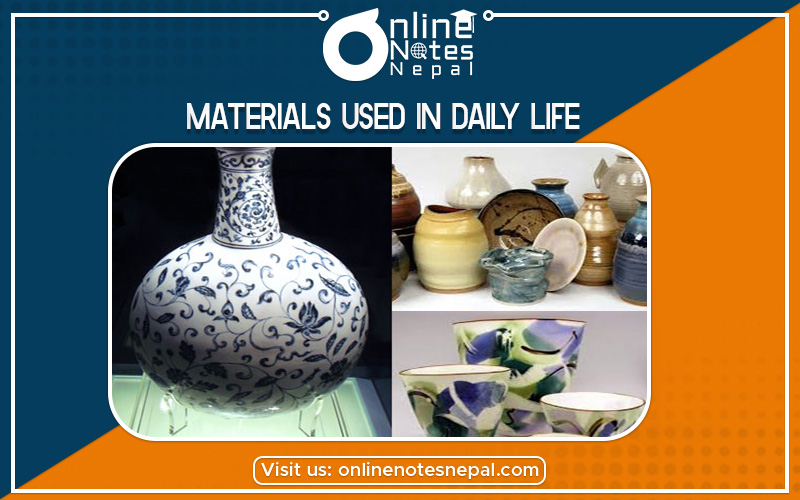Published by: Nuru
Published date: 06 Jul 2021

Some of the materials used in daily life are Wood, silk, cotton, leather, rubber, coal, etc. However, some materials that we use are man-made. Synthetic textiles like terylene and nylon, cement, glass, plastics, dyes, soap, detergents, fertilizers, insecticides, and pesticides are some man-made materials that are commonly used.
A cement is a binder, a substance used for construction that sets, hardens, and adheres to other materials to bind them together. Cement is seldom used on its own, but rather to bind sand and gravel (aggregate) together. It is prepared by heating calcium carbonate (CaCO3) and a special kind of clay (Al2O3.SiO2) at a temperature of 1600°C.
Glass is a hard transparent substance that is used to make things such as windows and bottles. Glass is used to mean objects made of glass, for example, drinking containers and bowls. Ordinary glass is made from a mixture of 50% Silica, 15% Sodium Carbonate, 10% Calcium Carbonate, and 25% glass pieces.
Hard glass is made by heating silica with potassium carbonate and calcium carbonate at 1500°C.
Soft glass is made by a mixture of 50% Silica, 15% sodium carbonate, 10% calcium carbonate, and 25% glass pieces.
Hard glass is used in making hard glass laboratory apparatus like test tubes, beakers, and tube lightest.
Soft glass is used in making window panes, light bulbs, and other objects.
Ceramic material is an inorganic, non-metallic, often crystalline oxide, nitride, or carbide material. Some elements, such as carbon or silicon, may be considered ceramics. Ceramic materials are brittle, hard, strong in compression, and weak in shearing and tension. For the production of ceramics, clay is crushed, ground, and sieved to get fine clay. Then it is mixed in water to make a paste known as slip. The slip formed is molded into different shapes and dried. The hardened shapes are put into a furnace and a little salt is added to make it shiny. This makes porcelain non-porous, smooth and shiny. Colors are added to make the ceramics objects attractive.
Fibre is a thin thread of a natural or artificial substance, especially one that is used to make cloth or rope. If you look at the paper under a microscope you will see the fibres. Fibre consists of the parts of plants or seeds that your body cannot digest. Natural fibres are the fibres which are obtained from natural sources. Example: Animal fibres, Cotton fibres etc. Artificial fibres are the fibres which are made artificially. Example: Rayon, Nylon etc.
| Soaps | Detergents |
| They are metal salts of long-chain higher fatty acids. | These are sodium salts of long-chain hydrocarbons like alkyl sulphates or alkyl benzene sulphonates. |
| These are prepared from vegetable oils and animal fats. | They are prepared from hydrocarbons of petroleum or coal. |
| They cannot be used effectively in hard water as they produce scum i.e., insoluble precipitates of Ca2+, Mg2+, Fe2+ etc. | These do not produce insoluble precipitates in hard water. They are effective in soft, hard or saltwater. |
| These cannot be used in acid solutions. | They can be used even in acid solutions. |
| Their cleansing action is not as strong as that of detergents. | Their cleansing action is by surfactants, which is a strong cleansing action. |
| These are biodegradable. | Some of these are not biodegradable. |
Pesticides are substances that are meant to control pests, including weeds. In general, a pesticide is a chemical or biological agent (such as a virus, bacterium, or fungus) that deters, incapacitates, kills, or otherwise discourages pests. Types are:
Organic Insecticides:
They are the synthetic compounds made up of carbon, hydrogen, and oxygen. There are three kinds of organic insecticides. They are chlorinated hydrocarbon, organic phosphate and carbamates. Example: BHC (Benzene hexachloride), DDT (DichloroDiphenylTrichloro ethane) etc.
Inorganic insecticides:
Inorganic insecticides are made from minerals. They include calcium arsenate, lead arsenate, fluoride and lime sulphur. They are used in order to protect cotton, fruits vegetables etc. Example: Baygon, Temik etc.
A fertilizer is a natural or synthetic, chemical-based substance that is used to enhance plant growth and fertility. Fertilizers typically offer the three major macronutrients potassium, phosphorus, and nitrogen. A good fertilizer not only supplies the essential nutrients required by the plant but also nourishes the microorganisms, which helps to maintain the fertility of the soil. Types are:
Organic fertilizers:
Organic fertilizers are the substance obtained from the decay of animals and plants or the waste products of animals. They provide necessary nutrients to plants. It can be further categorized into two types: I. Green manure II. Compost manure
Chemical fertilizers:
Chemical fertilizers are the fertilizers, which are prepared artificially using inorganic compounds that are used in order to overcome the deficiencies of the plant nutrients.
It can be further subdivided into three parts:
a. Nitrogen fertilizers
b. Phosphorous fertilizers
c. Potassium fertilizers